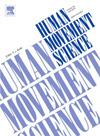Higher entropy in movements may promote enhanced upper limb motor precision
IF 1.9
3区 心理学
Q4 NEUROSCIENCES
引用次数: 0
Abstract
The Optimal Movement Variability Hypothesis posits that healthy movements exhibit an optimal structure of variability, characterized by fractal patterns, which confer both stability and flexibility in motor control. This optimal, fractally-structured, variability has been associated with reduced metabolic cost during walking and enhanced resilience to perturbations. However, the full extent of the potential benefits of this variability remains largely unexplored. Our study aims to investigate whether training sessions involving movement synchronization to a variable fractally structured auditory cueing device can also enhance dexterity and reduce miss percentage in a Fitts' law task. Twenty-four participants were randomly assigned to three groups: two groups received training involving wrist oscillations synchronized to an auditory cue with a fractal structure or self-paced wrist oscillations without a cue, while the third group received no training. Following four training sessions, the training groups completed a post-Fitts' Law task to assess any improvements in dexterity, while the untrained group completed the post-Fitts' Law task two weeks after their initial assessment. The results indicated that all groups improved accuracy, although there was no enhancement in the speed of striking the targets. Contrary to our hypothesis, the fractally structured auditory cued training group did not demonstrate superior performance compared to the self-paced and no-training groups. However, subjects who showed improvement on the post-Fitts' Law task exhibited higher movement sample entropy during the training task, irrespective of the training group they were in. These results suggest that while a generalized fractal variability training program may not enhance dexterity for young adults, individuals with high movement unpredictability may possess a greater capability for motor learning.
运动中较高的熵可能促进上肢运动精度的提高
最优运动变异性假说认为,健康的运动表现出最优的变异性结构,以分形模式为特征,这赋予了运动控制的稳定性和灵活性。这种最佳的、分形结构的可变性与行走时的代谢成本降低和对扰动的恢复能力增强有关。然而,这种可变性的潜在益处的全部程度在很大程度上仍未得到探索。我们的研究目的是探讨运动同步与可变分形结构听觉提示装置的训练是否也可以提高灵巧性和减少菲茨定律任务的遗漏率。24名参与者被随机分为三组:两组接受训练,包括与分形结构的听觉提示同步的手腕摆动,或者在没有提示的情况下进行自节奏手腕摆动,而第三组没有接受训练。经过四次训练后,训练组完成了菲茨法后的任务,以评估灵巧性的任何改善,而未经训练的组在初始评估后两周完成了菲茨法后的任务。结果表明,所有组都提高了准确性,尽管击中目标的速度没有提高。与我们的假设相反,分形结构听觉提示训练组与自定节奏组和非训练组相比并没有表现出优越的表现。然而,在菲茨定律后任务中表现出改善的受试者在训练任务中表现出更高的运动样本熵,无论他们在哪个训练组。这些结果表明,虽然广义的分形可变性训练计划可能不会提高年轻人的灵活性,但运动不可预测性高的个体可能具有更强的运动学习能力。
本文章由计算机程序翻译,如有差异,请以英文原文为准。
求助全文
约1分钟内获得全文
求助全文
来源期刊

Human Movement Science
医学-神经科学
CiteScore
3.80
自引率
4.80%
发文量
89
审稿时长
42 days
期刊介绍:
Human Movement Science provides a medium for publishing disciplinary and multidisciplinary studies on human movement. It brings together psychological, biomechanical and neurophysiological research on the control, organization and learning of human movement, including the perceptual support of movement. The overarching goal of the journal is to publish articles that help advance theoretical understanding of the control and organization of human movement, as well as changes therein as a function of development, learning and rehabilitation. The nature of the research reported may vary from fundamental theoretical or empirical studies to more applied studies in the fields of, for example, sport, dance and rehabilitation with the proviso that all studies have a distinct theoretical bearing. Also, reviews and meta-studies advancing the understanding of human movement are welcome.
These aims and scope imply that purely descriptive studies are not acceptable, while methodological articles are only acceptable if the methodology in question opens up new vistas in understanding the control and organization of human movement. The same holds for articles on exercise physiology, which in general are not supported, unless they speak to the control and organization of human movement. In general, it is required that the theoretical message of articles published in Human Movement Science is, to a certain extent, innovative and not dismissible as just "more of the same."
 求助内容:
求助内容: 应助结果提醒方式:
应助结果提醒方式:


